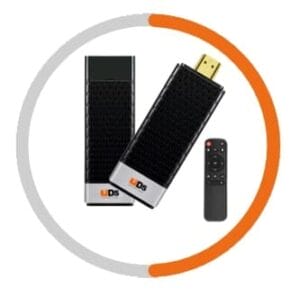In the fast-developing age of technology, the use of multiple screens to display information is becoming increasingly popular. A video wall controller is an optimal solution that helps connect and manage multiple screens easily and efficiently. In this article, we will learn about video wall controllers, how they work, and the benefits they provide.
1. What is a Video Wall Controller?
A Video Wall Controller is a device used to connect and control multiple independent screens to create a larger display and show images, videos, or advertising content synchronously across all screens. This controller can adjust and manage parameters such as size, position, brightness, contrast, and color of the screens to ensure accurate display and compatibility with advertising content. In the advertising field, the Video Wall Controller plays various important roles, specifically:
- Enhancing advertising effectiveness: A Video Wall Controller allows displaying advertising content larger, clearer, and more impressive than a single screen. This helps enhance the ability to attract customers and effectively convey advertising messages.
- Creating interactive experiences: With the ability to display dynamic multimedia content, a Video Wall Advertising Controller helps create interaction with customers. It can display videos, images, sounds, and special effects to create a unique experience and attract viewers’ attention.
- Easy management: The Video Wall Controller provides a simple and user-friendly interface to manage and control the screens. Users can easily change content, set display times, and adjust screen parameters.
- Flexible integration: The Video Wall Controller can integrate with various devices and systems such as computers, servers, cameras, and other end devices to create a complete and flexible advertising system.
- Cost savings: Instead of using multiple independent screens, using a Video Wall Advertising Controller helps save installation and screen management costs. It also minimizes dispersion and increases the consistency of advertising content.
2. VDSignage App
2.1 Video wall controller
The VDS connection device is an important part of the VDSignage video wall system. It allows connecting the video walls to the controller through a LAN or wireless network. This helps create a flexible environment and easily manage the video walls remotely.

2.2 VDSignage App
VDSignage App is a simple and easy-to-use application for managing content on video walls. You can create and edit presentations, videos, images, and messages displayed on the video wall easily. The app offers flexible features such as broadcasting schedules and multi-screen presentations, helping you optimize the effectiveness of your advertising and messaging.
With the VDSignage video wall controller, you can manage and control content displayed on multiple video walls from a single location. This helps you effectively communicate messages and advertisements to customers and attract them without having to control each screen separately.

3. The technology behind the video wall controller
The video wall controller is a unique and advanced technology that allows multiple screens to be combined to create a larger screen, called a video wall. This is a common technology in the field of advertising, event presentations, and similar applications. Behind the video wall controller are:
3.1 Synchronized image and sound display techniques
- Image display technology: Video walls use technologies such as LCD, LED, or OLED to display images. Each individual screen has a number of pixels to create a complete image when combined. To ensure synchronized images on each screen, the controller must process video signals to ensure that all screens display the same content accurately and with no delay.
- Sound technology: For screens with sound, the controller must also ensure synchronized sound on each combined screen. This ensures that the sound and image are reproduced perfectly, creating a better multimedia experience.

3.2 Standard connection and protocols used in video wall controllers
- Connection standards: There are several common connection standards used in video wall controllers, including HDMI (High-Definition Multimedia Interface), DisplayPort, and DVI (Digital Visual Interface). These standards allow for the transmission of video and audio signals from sources to the displays.
- Protocols: To ensure the control and adjustment of the video walls, controllers typically use protocols such as RS232, RJ45, or USB to connect and transmit data between the controller and the displays. This protocol allows users to remotely adjust display settings such as brightness, color, and resolution on the video walls.
4. Special features of the video wall controller
- Integrated multiple signal sources: The video wall controller allows connecting and controlling multiple input signal sources, such as computers, projectors, DVD players, cameras, and more. This helps users easily switch between signal sources and control them through a single controller.
- Multi-screen display: The video wall controller enables users to connect and display content on multiple screens simultaneously. This is very useful in situations that require multi-point display, such as presentations, advertising, broadcasting, and conferences.
- Screen splicing function: The video wall controller provides the ability to splice multiple screens together to create a larger display. Users can customize the configuration of the video wall, such as stacking, horizontal or vertical alignment, to create unique display effects and attract attention.
- Remote control: The video wall controller typically comes with a remote control, allowing users to remotely control the functions and settings of the screen easily. Users can change content, adjust brightness, volume, and perform other operations without direct access to the controller.
- Signal management and control: The video wall controller offers optimal signal management and control features. Users can customize resolution, refresh rate, aspect ratio, and other parameters to ensure the best image quality on the video wall.
- Integrated audio system: In addition to controlling the screen, the video wall controller also allows users to integrate an audio system to provide a vibrant sound experience. Users can connect speakers, microphones, or other audio devices to enhance the sound for presentations or communications.

5. Advantages of the splicing advertising screen controller
- Flexibility and expandability: The splicing advertising screen controller allows connecting and controlling multiple screens at the same time, creating a larger screen with a wider display space. This helps optimize advertising space and attract customer attention.
- High performance and stability: The splicing advertising screen controller is designed to operate stably and reliably, ensuring high performance in displaying advertising content. This helps avoid screen lagging or issues during the presentation.
- Accurate and sharp color reproduction ability: The splicing advertising screen controller has the ability to reproduce colors accurately and sharply, helping display images and videos with high quality. This enhances the aesthetics and attractiveness of advertising, attracting viewer attention.
- Energy-saving and long lifespan: The splicing advertising screen controller is designed to save energy, helping reduce operating costs. At the same time, it also has a long lifespan, ensuring that the screen can operate continuously for a long time without issues.
- High resolution and ability to display various content: The splicing advertising screen controller supports high resolution, allowing detailed and clear display of images and videos. Additionally, it can also display various content such as videos, images, text, optimizing the transmission of advertising messages.
6. The application of the advertising screen controller can be applied in many
The application of the integrated advertising screen controller can be applied in many different fields, helping to enhance marketing effectiveness and create a better experience for customers. Here are some specific examples:
6.1 Outdoor advertising:
- Use the integrated advertising screen controller on large outdoor billboards to attract customer attention. This helps enhance advertising effectiveness and attract a large audience.
- Display dynamic advertising content, change according to time and day of the week to bring freshness and attract customers.
6.2 Shopping malls and restaurants:
- Use the integrated advertising screen controller in shopping malls and restaurants to create an enjoyable experience for customers. Screens can display product information, menus, promotions, or directions.
- Provide diverse and engaging content to attract customer attention and increase product marketing capabilities.
6.3 Events and exhibitions:
- Use the integrated advertising screen controller in events and exhibitions to create a vibrant stage. Large multimedia screens can convey messages, videos, and images to attract attention and create interest for the audience.
- At the same time, the integrated advertising screen controller can also provide information about the event, schedule, and directions for attendees.
6.4 Public transportation:
- Use the integrated advertising screen controller in public transportation to provide useful information and advertising to customers during travel. Screens can display notifications about train/bus schedules, hot news, weather information, and product advertising.
- This helps to provide convenience for customers and offer an effective marketing channel for businesses.
Thus, the integrated advertising screen controller has a wide range of applications in enhancing marketing effectiveness and creating a better experience for customers in various fields.

7. Choosing the Right Video Wall Controller
7.1 Determine the specific requirements of the advertising project:
- You need to clearly define the specific requirements of your advertising project.
- Provide information such as desired size and resolution, number of screens to be tiled, installation location, required features, and project budget.
7.2 Evaluate key factors:
- Resolution: Choose a controller with a resolution that meets the project’s requirements.
- Screen size: Ensure that the controller can handle the desired screen size.
- Expandability: Check if the controller supports expandability to upgrade or change screens in the future.
7.3 Research reputable suppliers and brands:
- Research reputable suppliers and well-known brands in the market. Evaluate product quality, post-sales service, and supplier reliability.
7.4 Check compatibility:
- Verify the compatibility of the controller with other devices in the current advertising system, including management software and broadcasting devices.
- Ensure that the controller can connect and operate seamlessly with the screens and other components in your advertising system.
Note: Before selecting a video wall controller, consult with experts or suppliers to ensure that you have chosen a product that meets the needs and requirements of your advertising project.

8. Note when installing and operating the video wall controller
8.1 Ensure adequate space and suitable environment for the video wall:
- Determine the installation location so that the advertising screen can be clearly visible from all angles.
- Ensure there are no obstacles obstructing the screen, such as trees or buildings.
8.2 Place banners and advertising content in a reasonable manner to attract customer attention:
- Use images, colors, and fonts suitable for the advertised product or service.
- Display concise and easy-to-understand information, avoid overloading information that may be uncomfortable for customers.
8.3 Ensure information security and privacy in the video wall advertising:
- Check and secure the network system to prevent advertising information from being invaded or tampered with.
- Comply with regulations on privacy rights and protect customers’ personal data.
8.4 Perform regular maintenance and checks to maintain optimal performance:
- Check components and connection cables to ensure no technical issues affecting the screen’s performance.
- Update the latest software and firmware to leverage advanced features and fix occurring errors.
Remember to follow the above guidelines for installing and operating the video wall controller efficiently and reliably.
The video wall controller is an advanced technology that helps enhance the multi-screen display advertising experience for Restaurants, Nail Salons. From increasing revenue for Restaurants, Nail Salons to creating a luxurious, upscale space for them and displaying content from various video sources. The video wall controller allows remote management, quick information editing bringing many benefits to users. With features like screen splitting, source switching, and screen synchronization, the VDSinage video wall controller becomes a useful tool in presentation, advertising, monitoring, and control applications. To learn more about VDS products, please refer to: VDSignage Geodetic Advertising Screen Management Solution.
Copyright © by VDSignage.
